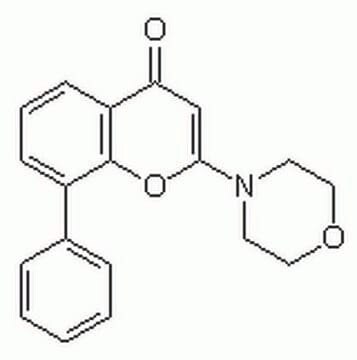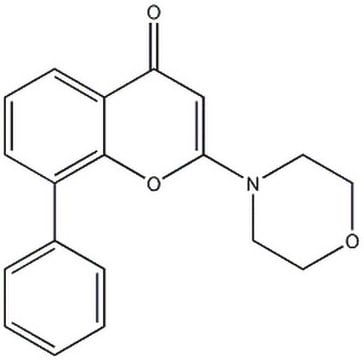440202
LY 294002
≥98% (HPLC), solid, PI3K inhibitor, Calbiochem®
Synonym(e):
LY 294002
About This Item
Empfohlene Produkte
product name
LY 294002, LY294002, CAS 154447-36-6, is a cell-permeable, potent, reversible, and specific inhibitor of PI 3-kinase ((IC₅₀ = 1.4 µM). Acts on the ATP-binding site.
Qualitätsniveau
Assay
≥98% (HPLC)
Form
solid
Hersteller/Markenname
Calbiochem®
Lagerbedingungen
OK to freeze
protect from light
Farbe
off-white
Löslichkeit
DMSO: 20 mg/mL
ethanol: soluble
Versandbedingung
ambient
Lagertemp.
−20°C
InChI
1S/C19H17NO3/c21-17-13-18(20-9-11-22-12-10-20)23-19-15(7-4-8-16(17)19)14-5-2-1-3-6-14/h1-8,13H,9-12H2
InChIKey
CZQHHVNHHHRRDU-UHFFFAOYSA-N
Allgemeine Beschreibung
Biochem./physiol. Wirkung
Phosphatidylinositol-3-Kinase
Warnhinweis
Angaben zur Herstellung
Rekonstituierung
Sonstige Hinweise
Bechard, M., and Dalton. S. 2009. Mol. Cell. Biol.29, 2092.
Lianguzova, M.S. et al. 2007. Cell Biol. Int.31, 330.
Baumann, P., and West, S.C. 1998. Proc. Natl. Acad. Sci. USA 95, 14066.
Cardone, M.H., et al. 1998. Science282, 1318.
Vlahos, C.J., et al. 1995. J. Immunol.154, 2413.
Yano, H., et al. 1995. Biochem. J.312, 145.
Vlahos, C.J., et al. 1994. J. Biol. Chem.269, 5241.
Selected Citations
Lee, J., et al. 2009. <;A href="http://www.cell.com/cell-stem-cell/abstract/S1934-5909(09)00211-2"Cell Stem Cell<;/A>;5, 76.
Rechtliche Hinweise
Lagerklassenschlüssel
11 - Combustible Solids
WGK
WGK 2
Flammpunkt (°F)
487.4 °F
Flammpunkt (°C)
253.0 °C
Analysenzertifikate (COA)
Suchen Sie nach Analysenzertifikate (COA), indem Sie die Lot-/Chargennummer des Produkts eingeben. Lot- und Chargennummern sind auf dem Produktetikett hinter den Wörtern ‘Lot’ oder ‘Batch’ (Lot oder Charge) zu finden.
Besitzen Sie dieses Produkt bereits?
In der Dokumentenbibliothek finden Sie die Dokumentation zu den Produkten, die Sie kürzlich erworben haben.
Kunden haben sich ebenfalls angesehen
Unser Team von Wissenschaftlern verfügt über Erfahrung in allen Forschungsbereichen einschließlich Life Science, Materialwissenschaften, chemischer Synthese, Chromatographie, Analytik und vielen mehr..
Setzen Sie sich mit dem technischen Dienst in Verbindung.













